ccu cgg cgg gca The 12 letters that changed the world
The genome of the new coronavirus harbors a short sequence suspected of being the main culprit of its uniquely infectious and aggressive nature
The vicious enemy that has forced billions of people into hiding in their homes is a tiny ball measuring about 70 millionths of a millimeter, making it to a human being what a chicken is to the entire planet. And this is humanity¡¯s great adversary. Known to scientists as SARS-CoV-2, the novel coronavirus is just a very short message written in different combinations of the same four letters. Each letter is the initial of a chemical compound containing different amounts of carbon, hydrogen, nitrogen and oxygen. It is these four letters (a, u, g, c) that have written the code that has killed more than 300,000 people since it was first was detected little more than four months ago.
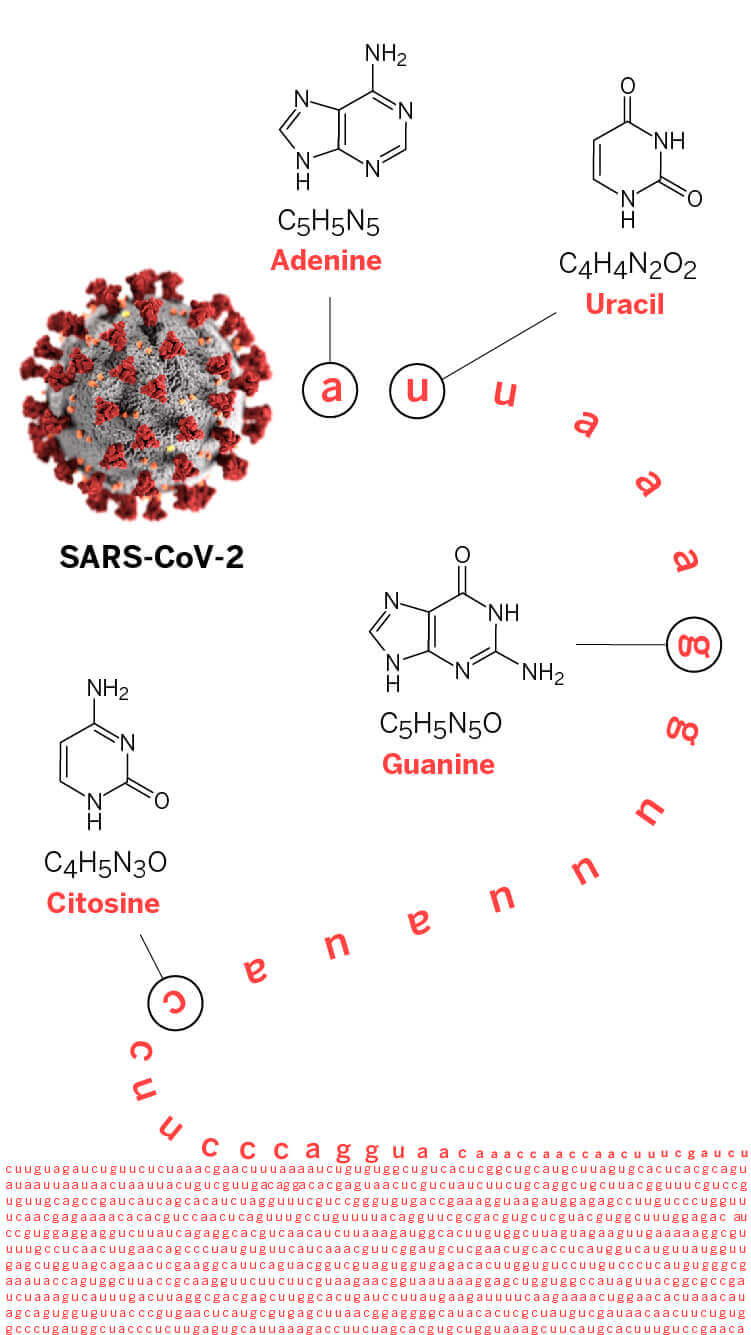
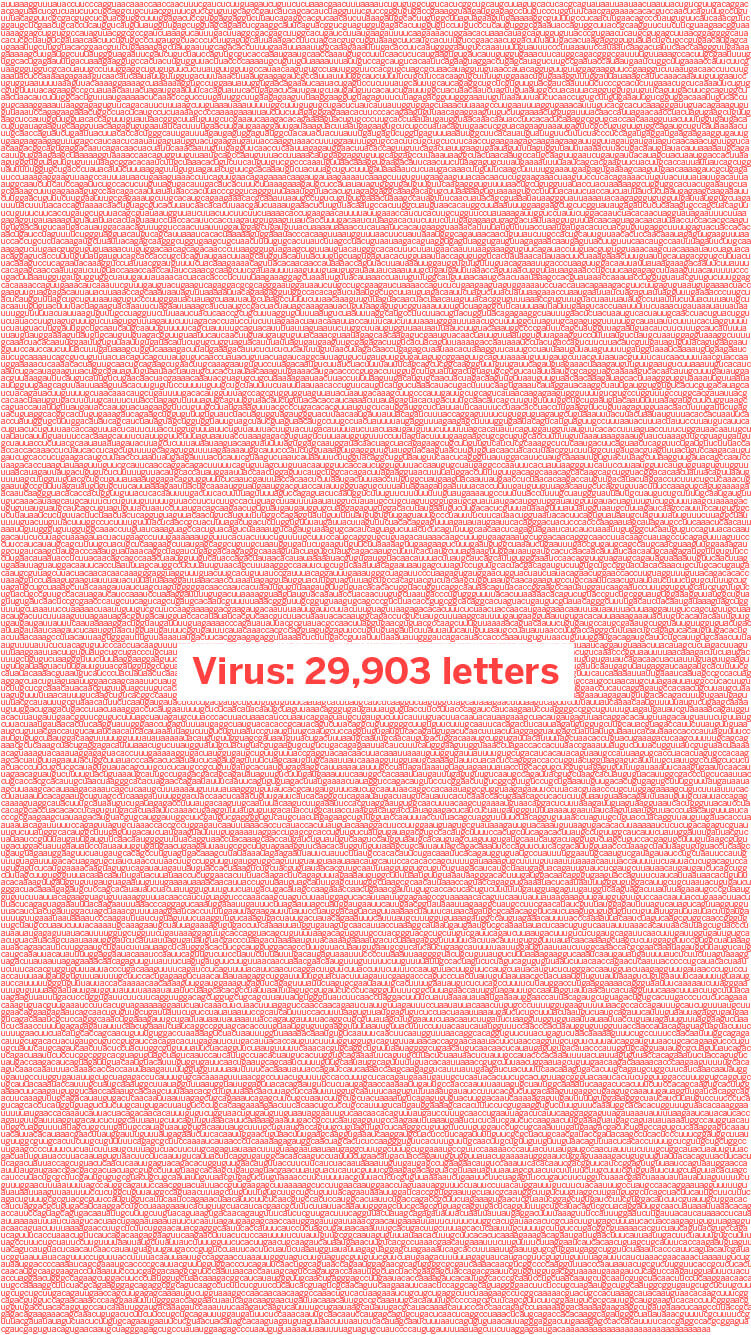
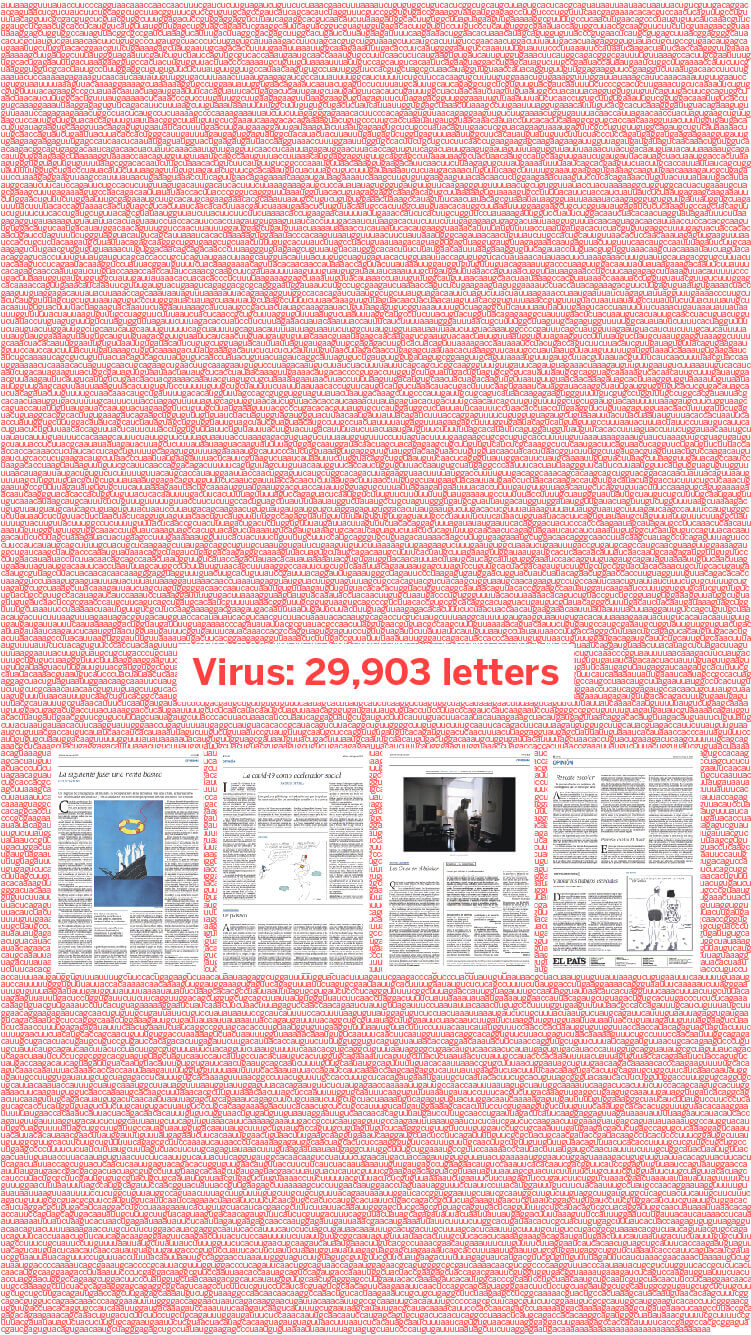
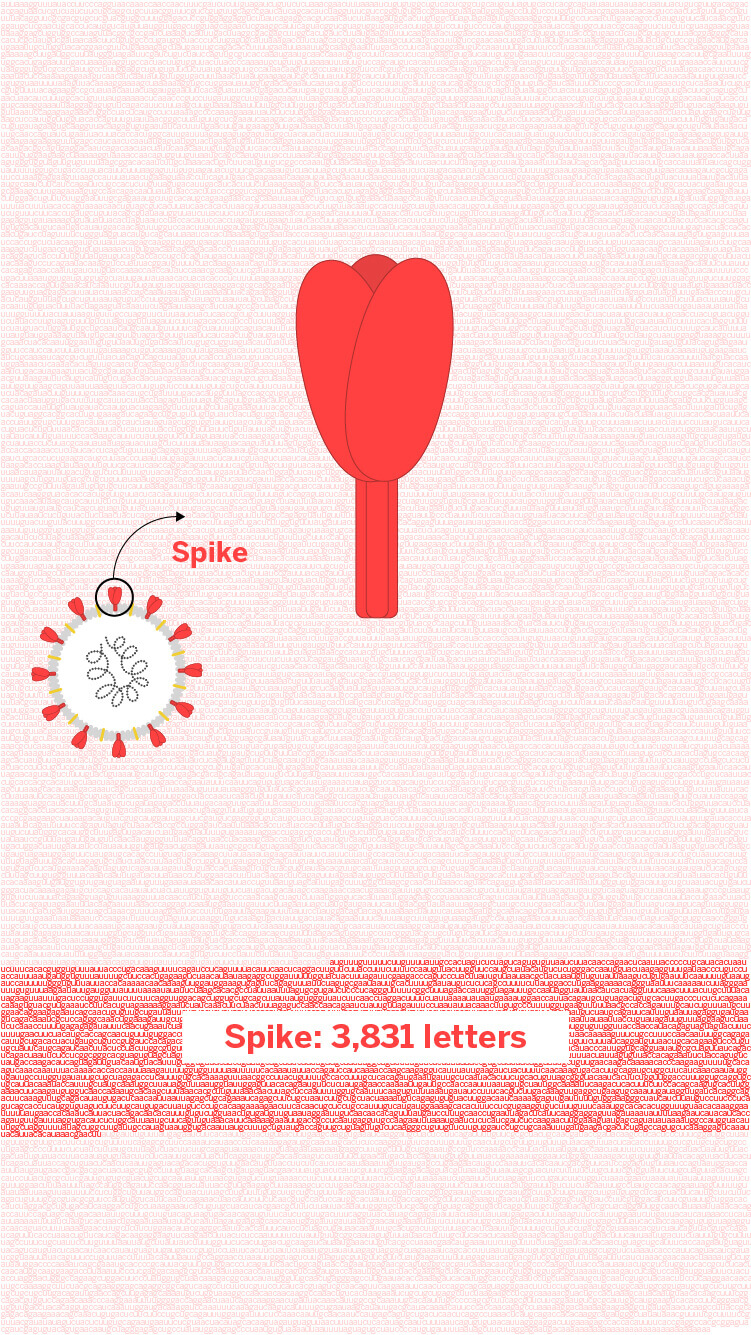
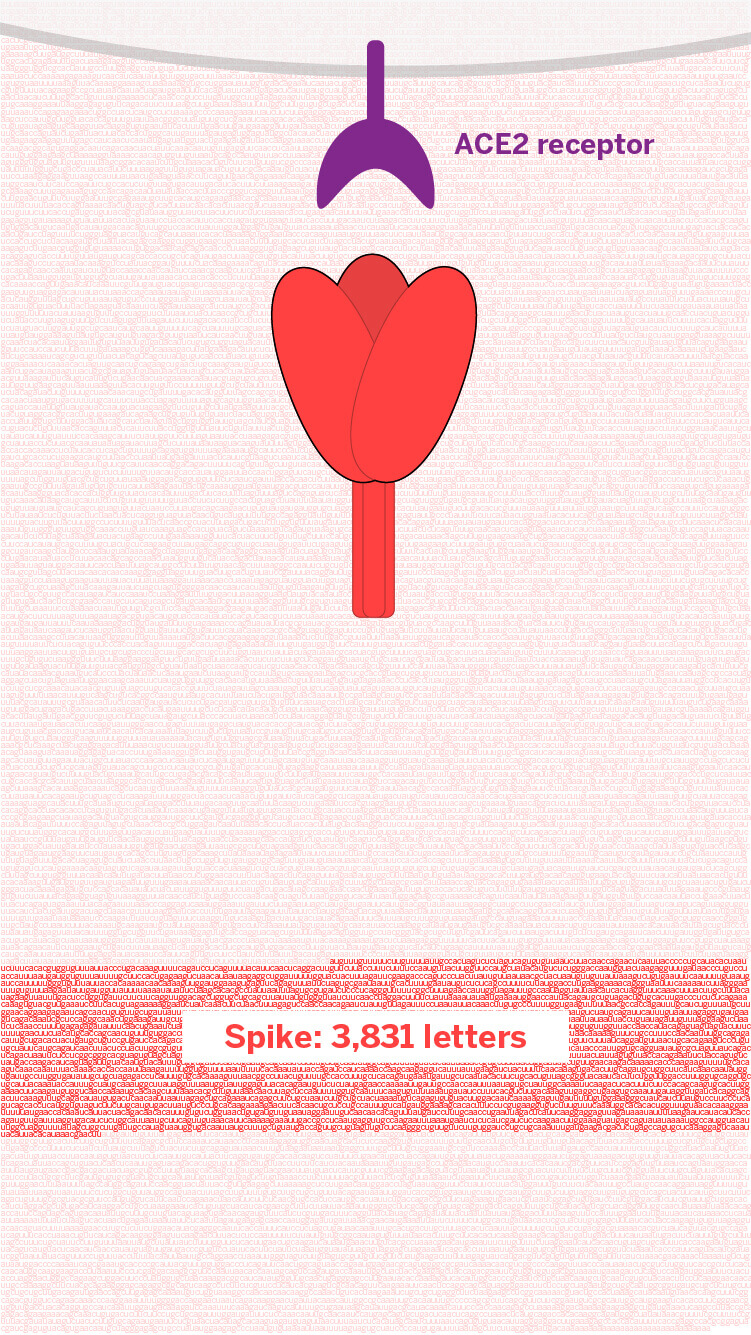
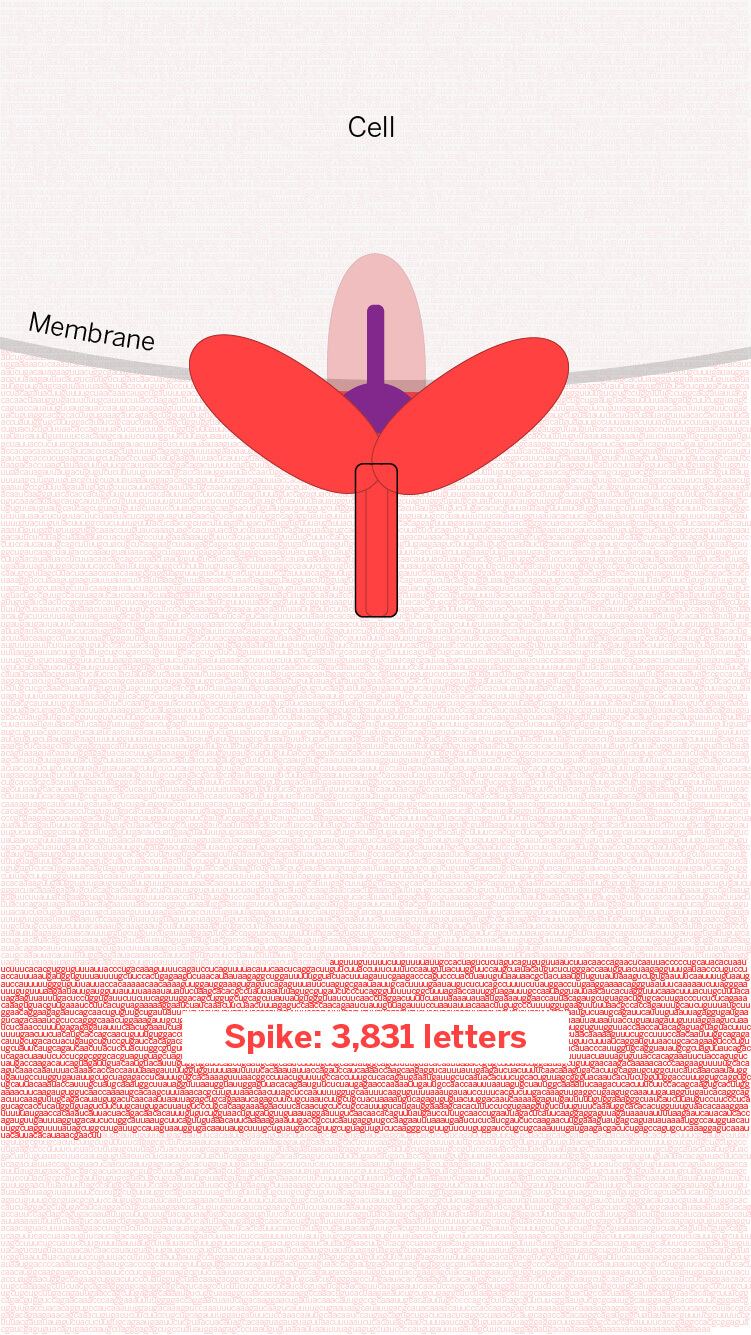
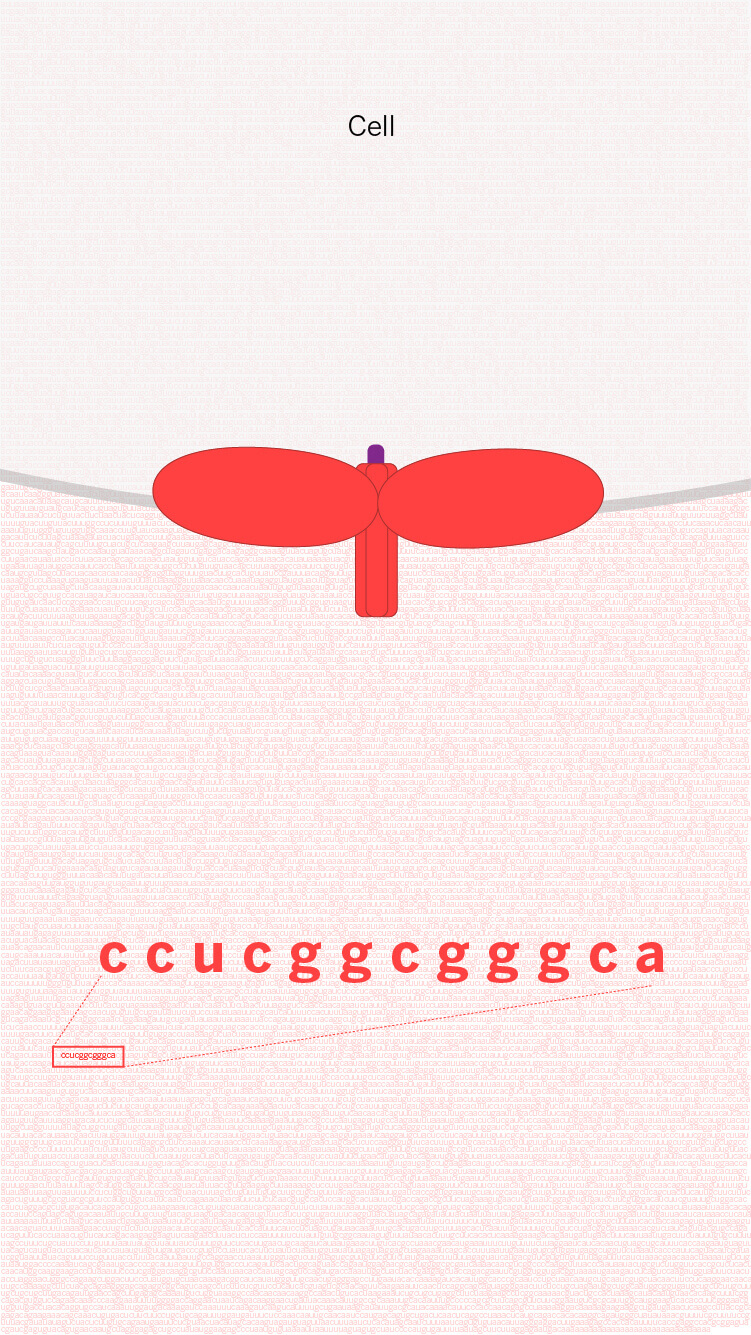
This genetic material, called RNA, and which some viruses inherit from others, works like an instruction manual for manufacturing the proteins that form SARS-CoV-2.
The genome of the new coronavirus has around 30,000 letters with enough instructions to penetrate a cell, hijack its machinery and make thousands of copies of itself.
The entire genome of SARS-CoV-2 would fit on four pages of EL PA?S.
The instructions for the human cell to manufacture the virus¡¯s main weapon ¨C its spike protein used as a key by new viruses to gain access to more and more cells ¨C is contained in around 4,000 letters.
The coronavirus spike protein is like a double-faceted key. It first latches onto the lock ¨C the human cell¡¯s ACE2 receptor.
Its next step is to control the binding of the virus¡¯s membrane to the cell¡¯s membrane.
The main difference between SARS-CoV-2 and other coronaviruses is the appearance of 12 extra letters in its genome. The experts flag up this extremely short sequence as the main culprit regarding its virulence.
A shocking virus
SARS-CoV-2 is unique. Respiratory viruses usually infect either the throat or the lungs. Those that concentrate in the throat cause milder symptoms but spread very easily. Viruses that penetrate the lungs cause more severe illness but are much less infectious. SARS-CoV-2 is both very contagious and potentially very aggressive.

The seasonal flu virus breeds in the throat and is spread via respiratory droplets.
Upper
airways
Fatality rate
0.1%
Total infected
1 billion a year
The severe acute respiratory syndrome (SARS-CoV-1), which emerged in 2002, caused fatal pneumonia but was not particularly infectious.
Bronchi,
Bronchioles
and Alveolus
Fatality rate
10%
Total infected
8,000
in 6 months
The coronavirus SARS-CoV-2 has a multiplication rate in the throat a thousand times higher than SARS-CoV-1 and can cause fatal pneumonia as well as affecting other organs.
Fatality rate
0.5-1%
Confirmed cases
4.6 million
(in six months)
Cases confirmed as
at May 17, 2020.

The seasonal flu virus breeds in the throat and is spread via respiratory droplets.
Upper
airways
Total infected
1 billion a year
Fatality rate
0.1%
The severe acute respiratory syndrome (SARS-CoV-1), which emerged in 2002, caused fatal pneumonia but was not particularly infectious.
Bronchi,
Bronchioles
and Alveolus
Total infected
8,000
in 6 months
Fatality rate
10%
The coronavirus SARS-CoV-2 has a multiplication rate in the throat a thousand times higher than SARS-CoV-1 and can cause fatal pneumonia as well as affecting other organs.
Fatality rate
0.5-1%
Confirmed cases
4.6 million
(in six months)
Cases confirmed as
at May 17, 2020.
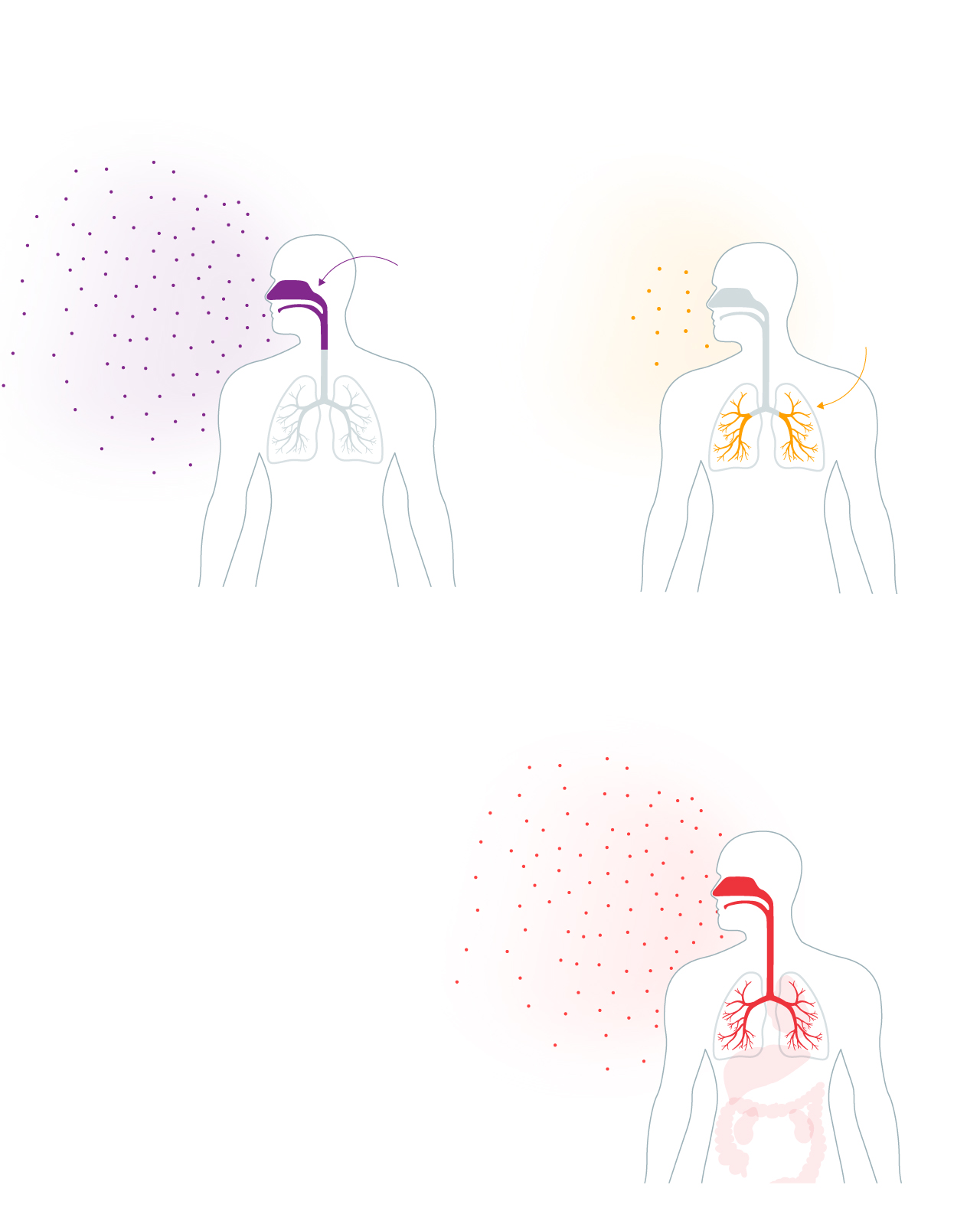
The severe acute respiratory syndrome (SARS-CoV-1), which emerged in 2002, caused fatal pneumonia but was not particularly infectious.
The seasonal flu virus breeds in the throat and is spread via respiratory droplets.
Upper
airways
Bronchi,
Bronchioles
and Alveolus
Fatality rate
0.1%
Total infected
1 billion a year
Fatality rate
10%
Total infected
8,000 in 6 months
The coronavirus SARS-CoV-2 has a multiplication rate in the throat a thousand times higher than SARS-CoV-1 and can cause fatal pneumonia as well as affecting other organs.
Confirmed cases
4.6 million (in six months)
Fatality rate
0.5-1%
Cases confirmed as at May 17, 2020.
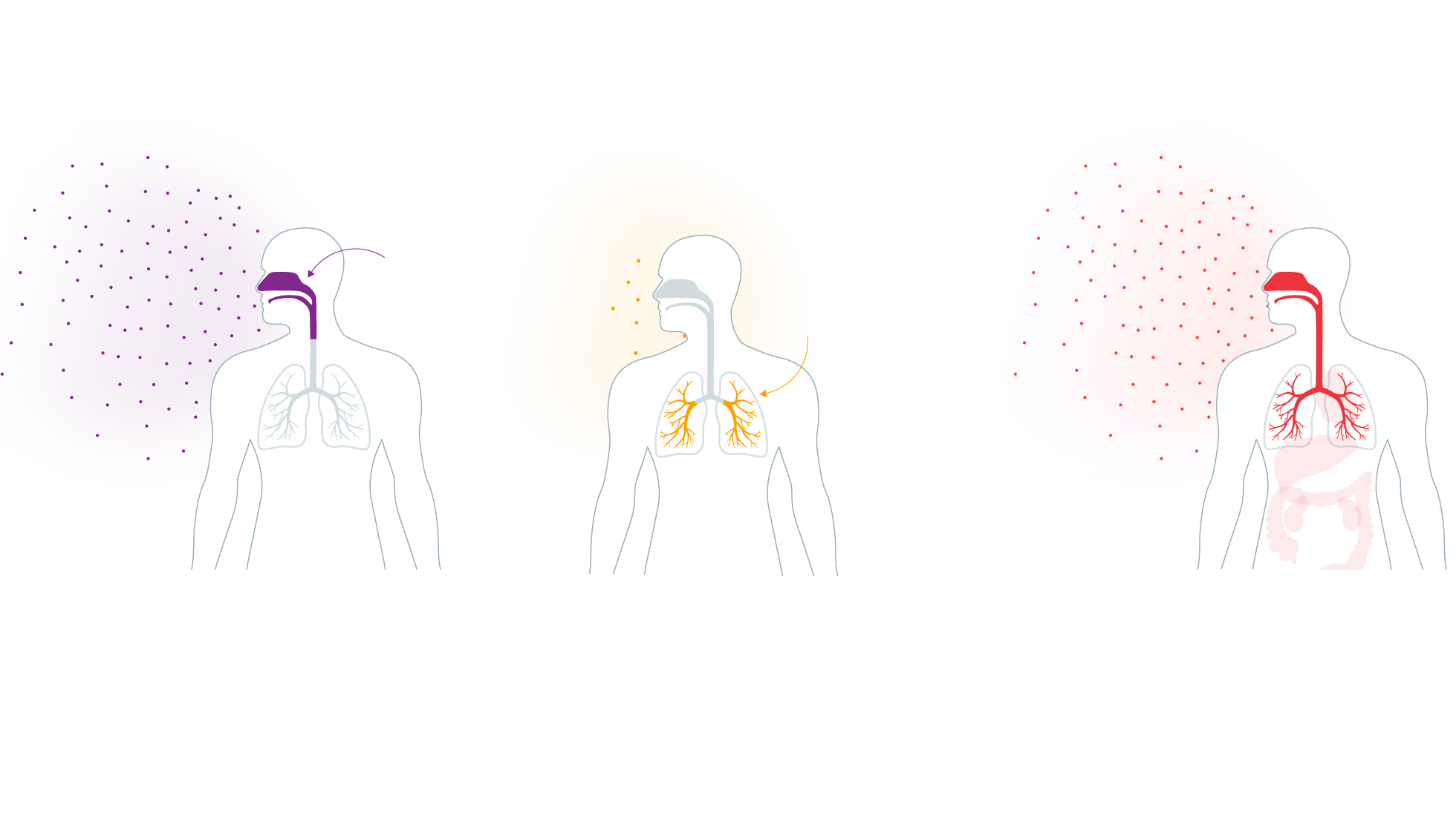
The coronavirus SARS-CoV-2 has a multiplication rate in the throat a thousand times higher than SARS-CoV-1 and can cause fatal pneumonia as well as affecting other organs.
The severe acute respiratory syndrome (SARS-CoV-1), which emerged in 2002, caused fatal pneumonia but was not particularly infectious.
The seasonal flu virus breeds in the throat and is spread via respiratory droplets.
Upper
airways
Bronchi,
Bronchioles
and Alveolus
Fatality rate
10%
Fatality rate
0.1%
Fatality rate
0.5-1%
Total infected
1 billion a year
Total infected
8,000 in 6 months
Confirmed cases
4.6 million (in six months)
Cases confirmed as at May 17, 2020.
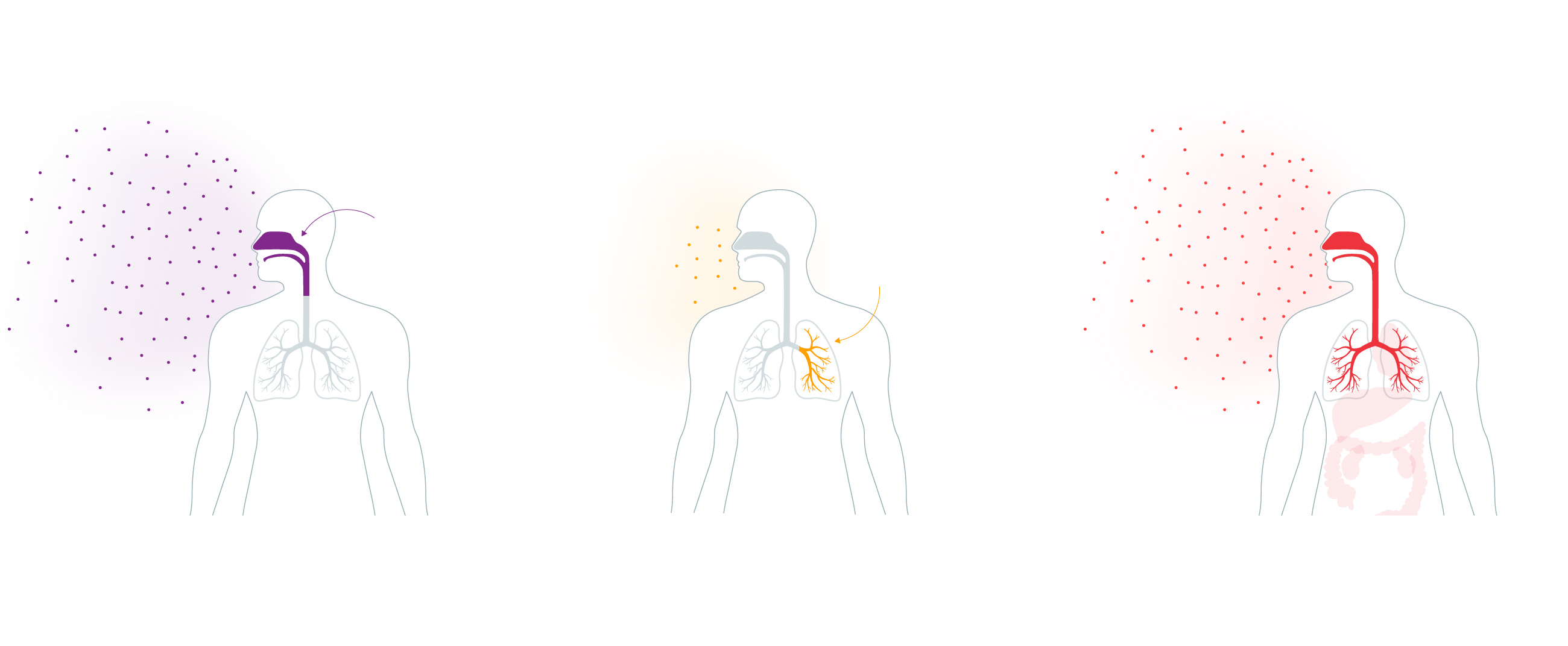
The severe acute respiratory syndrome (SARS-CoV-1), which emerged in 2002, caused fatal pneumonia but was not particularly infectious.
The coronavirus SARS-CoV-2 has a multiplication rate in the throat a thousand times higher than SARS-CoV-1 and can cause fatal pneumonia as well as affecting other organs.
The seasonal flu virus breeds in the throat and is spread via respiratory droplets.
Upper
airways
Bronchi, Bronchioles
and Alveolus
Fatality rate
0.1%
Total infected
1 billion a year
Fatality rate
10%
Total infected
8,000 in 6 months
Fatality rate
0.5-1%
Confirmed cases
4.6 million (in six months)
Cases confirmed as at May 17, 2020.
The head of the Demogorgon
Under the microscope, the new coronavirus looks like a morning star ¨C the spiked metal ball at the end of a chain used as a weapon during the Middle Ages. But when you zoom in on the spike proteins, the image is even scarier. In American biochemist Greg Bowman¡¯s laboratory, this barbed protein is referred to as ¡°the Demogorgon,¡± the monster in the Netflix show Stranger Things ¨C a creature with a humanoid body and a head like a carnivorous plant that devours its prey.
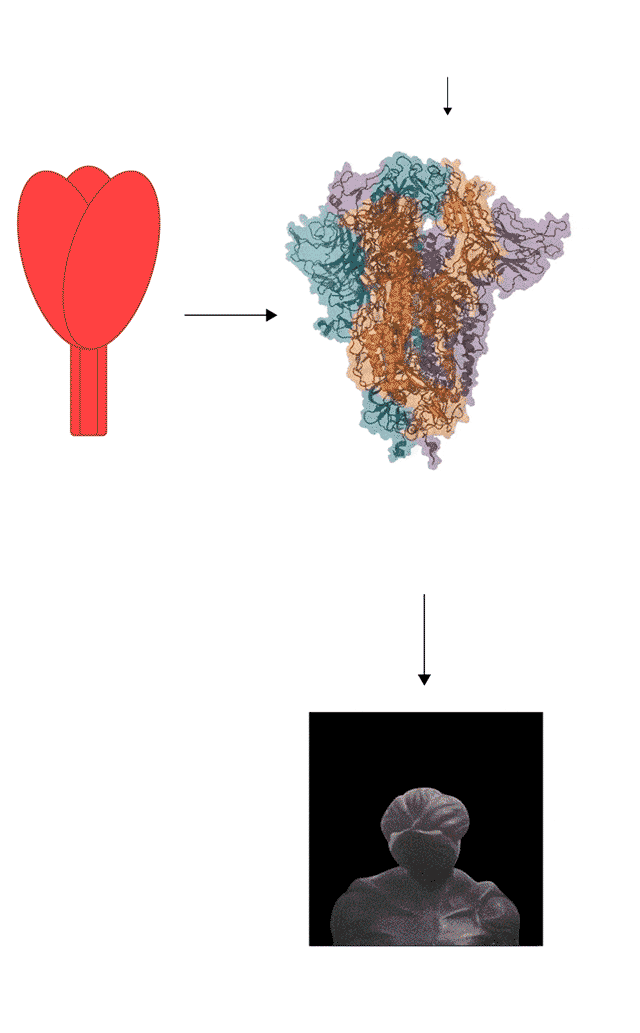
Space for the
ACE2 receptor
Diagram of the
spike protein
Simulation from Washington
University of the virus¡¯s spike protein
Demogorgon¡¯s head
¡®Stranger Things¡¯
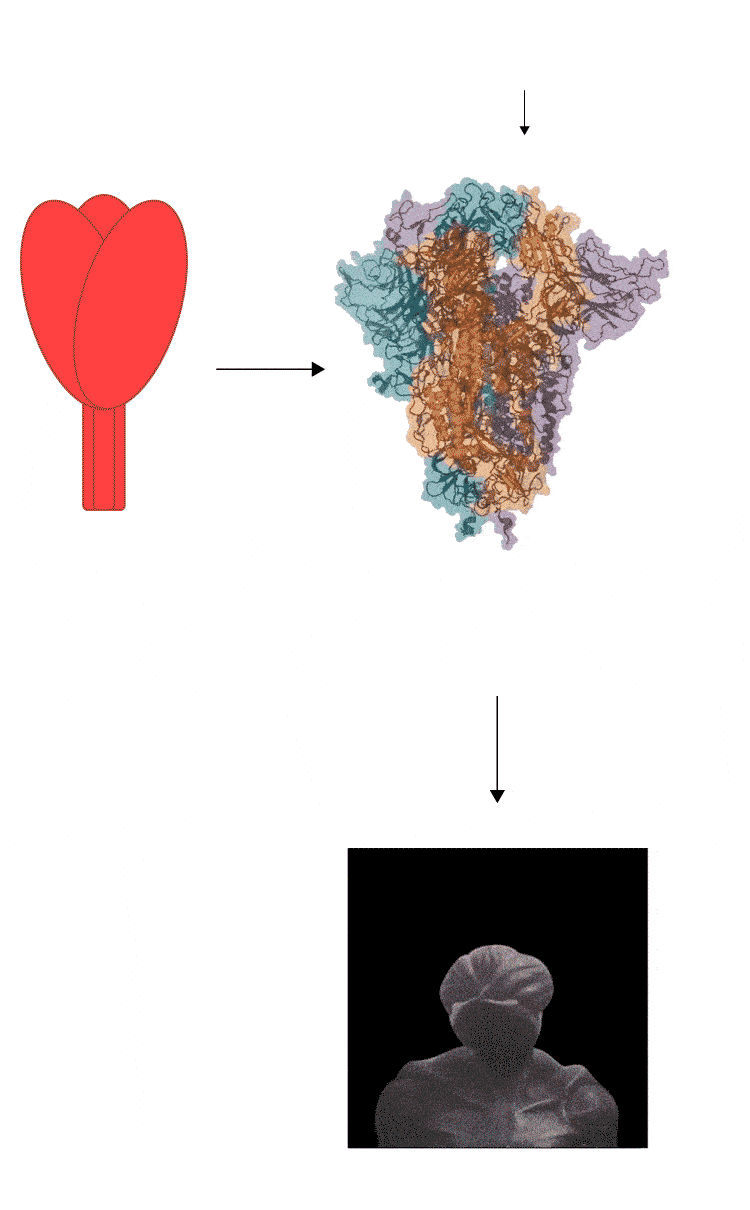
Space for the
ACE2 receptor
Diagram of the
spike protein
Simulation from Washington
University of the virus¡¯s spike protein
Demogorgon¡¯s head
¡®Stranger Things¡¯
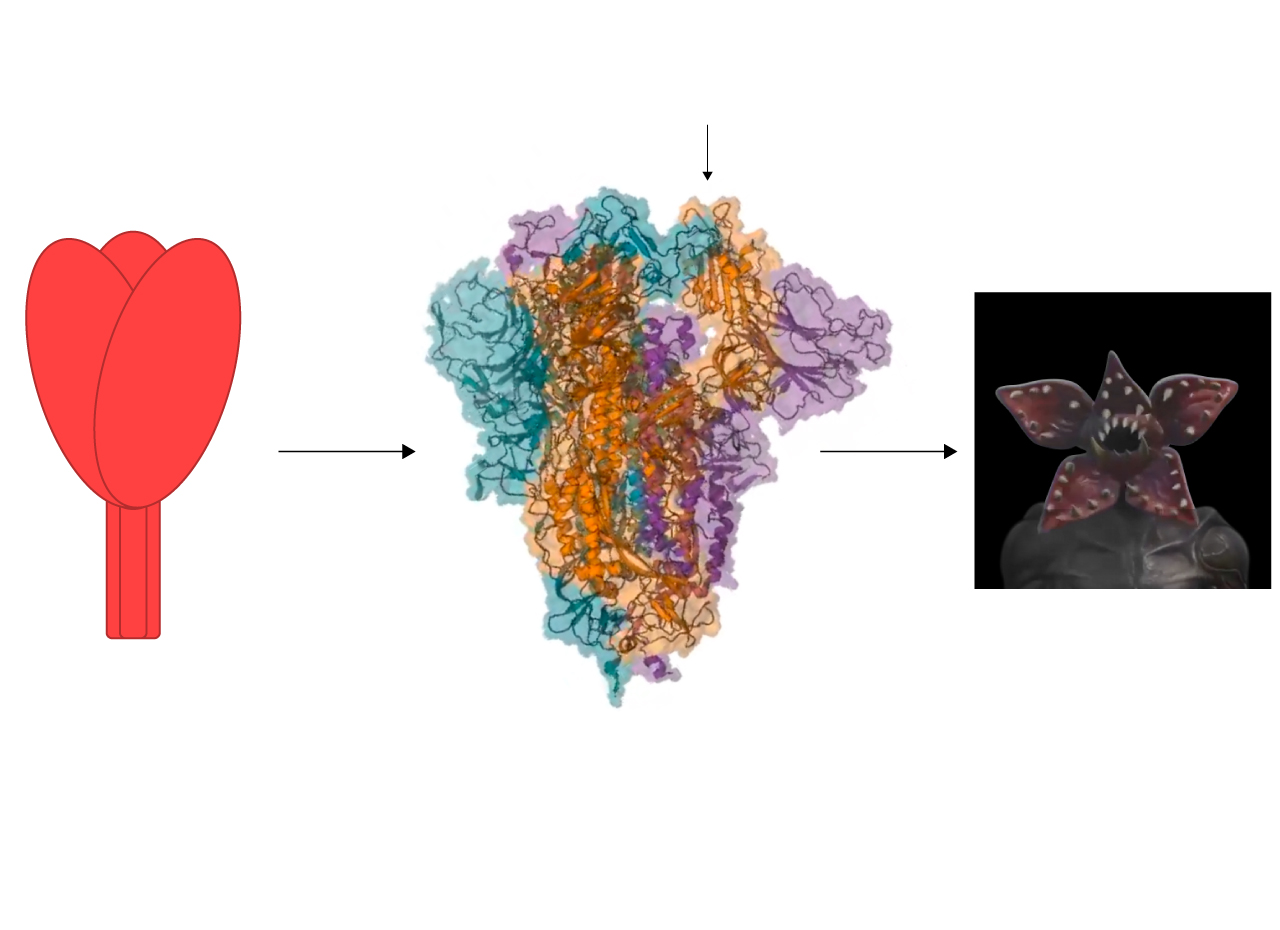
Space for the
ACE2 receptor
Diagram of the
spike protein
Simulation from Washington University
of the virus¡¯s spike protein
Demogorgon¡¯s head
¡®Stranger Things¡¯
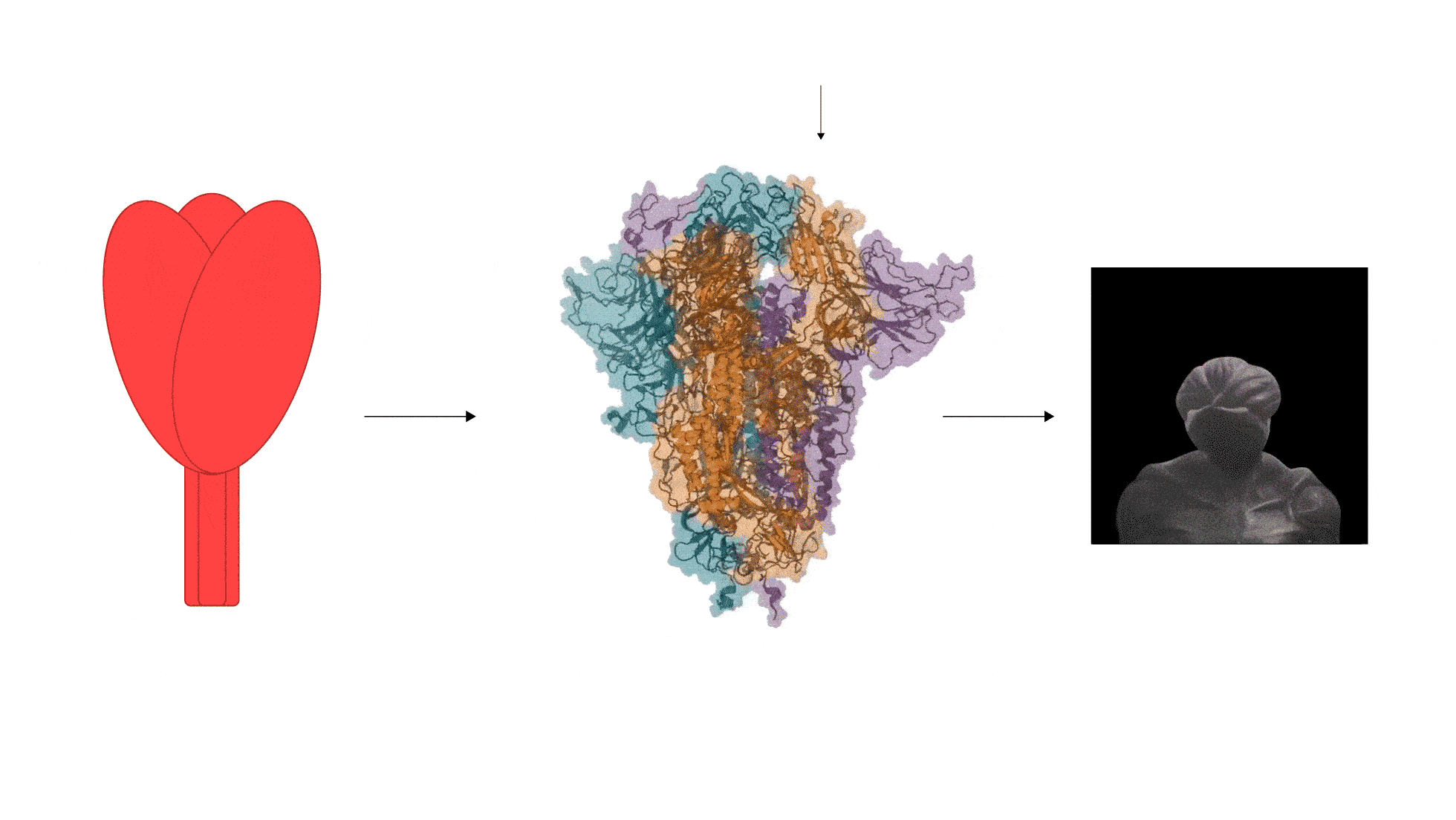
Space for
the ACE2 receptor
Diagram of the
spike protein
Simulation from Washington University
of the virus¡¯s spike protein
Demogorgon¡¯s head
¡®Stranger Things¡¯
A professor at Washington University, Bowman runs Folding@home, a project that uses the power of the computers of one million volunteers to recreate the behavior of the virus¡¯s spike protein. ¡°The ferocious Demogorgon opens its mouth to grab its human prey,¡± says Bowman with dramatic emphasis. In this case, the Demogorgon¡¯s prey is the ACE2 receptor, the lock on the human cell that the SARS virus already used far less efficiently in 2002. The new coronavirus has a ¡°key¡± that latches onto the lock 20 times better. But there is another factor that seems even more decisive in explaining why SARS-CoV-1, which is from the same family, killed fewer than 800 people while SARS-CoV-2 has already taken more than 300,000 lives; the enzyme called furin.
Pre-activation for the invasion
The coronavirus uses its spike protein as a double-faceted key.

1
The key¡¯s first step is to latch onto the human cell¡¯s ACE2 receptor, but that is not enough to actually invade it.
Coronavirus
Coronavirus
Spike
protein
ACE2
Receptor
Human
cell
C¨¦lula
humana
2
The key¡¯s second step mediates fusion of the viral and host cell membranes.
Cleavage of the virus¡¯s spike protein is required for viral entry. The 2002 SARS virus, which is from the same family, took advantage of two ¡°scissors¡± that are present in only a few cells ¨C namely, the TMPRSS2 enzyme and the cathepsin enzyme.
TMPRSS2
Cathepsins
Spike
protein
1
The virus latches onto
the ACE2 receptor
2
The cleavage of the spike
protein and the binding
with the cell.
TMPRSS2
Cathepsins
Human
cell
RNA
The virus releases its genome within the cell and starts to replicate.
To do this, it tricks the cell into creating virus proteins. These then assemble, multiply and start to infect other cells.
The virus¡¯s 12 extra letters create a site in the spike protein that can be cleaved by the furin enzyme which is present in almost all human cells, explaining this virus¡¯s elevated levels of contagion and virulence
Furin
Golgi
Apparatus
The furin makes the initial cleavage of the new virus¡¯s spike proteins, which now leave the human cell prepared for a new invasion.
Virus
pre-activated
by the furin
This initial cut allows the spike protein to start binding the infected cell to a healthy cell, enabling the virus to pass from one to another without being exposed to antibodies.
And so the process of infection and multiplication continues.

1
The key¡¯s first step is to latch onto the human cell¡¯s ACE2 receptor, but that is not enough to actually invade it.
Coronavirus
Coronavirus
Spike
protein
ACE2
Receptor
Human
cell
C¨¦lula
humana
2
The key¡¯s second step mediates fusion of the viral and host cell membranes.
Cleavage of the virus¡¯s spike protein is required for viral entry. The 2002 SARS virus, which is from the same family, took advantage of two ¡°scissors¡± that are present in only a few cells ¨C namely, the TMPRSS2 enzyme and the cathepsin enzyme.
TMPRSS2
Cathepsins
Spike
protein
1
The virus latches onto
the ACE2 receptor
2
The cleavage of the spike
protein and the binding
with the cell.
TMPRSS2
Cathepsins
Human
cell
RNA
The virus releases its genome within the cell and starts to replicate.
To do this, it tricks the cell into creating virus proteins. These then assemble, multiply and start to infect other cells.
The virus¡¯s 12 extra letters create a site in the spike protein that can be cleaved by the furin enzyme which is present in almost all human cells, explaining this virus¡¯s elevated levels of contagion and virulence
Furin
Golgi
Apparatus
The furin makes the initial cleavage of the new virus¡¯s spike proteins, which now leave the human cell prepared for a new invasion.
Virus
pre-activated
by the furin
This initial cut allows the spike protein to start binding the infected cell to a healthy cell, enabling the virus to pass from one to another without being exposed to antibodies.
And so the process of infection and multiplication continues.

1.
The key¡¯s first step is to latch onto the human cell¡¯s ACE2 receptor, but that is not enough to actually invade it.
2.
The key¡¯s second step mediates fusion of the viral and host cell membranes.
Cleavage of the virus¡¯s spike protein is required for viral entry. The 2002 SARS virus, which is from the same family, took advantage of two ¡°scissors¡± that are present in only a few cells ¨C namely, the TMPRSS2 enzyme and the cathepsin enzyme.
Coronavirus
Spike protein
TMPRSS2
Cathepsins
Spike
protein
ACE2
Receptor
Human
cell
But the SARS-CoV-2 also employs a third pair of scissors available from the furin.
The cleavage
of the spike
protein and
the binding
with the cell.
Human
cell
The virus latches
onto the ACE2
receptor
RNA
TMPRSS2
Cathepsins
The virus releases its genome within the cell and starts to replicate.
To do this, it tricks the cell into creating virus proteins. These then assemble, multiply and start to infect other cells.
The virus¡¯s 12 extra letters create a site in the spike protein that can be cleaved by the furin enzyme which is present in almost all human cells, explaining this virus¡¯s elevated levels of contagion and virulence
Furin
Golgi
Apparatus
The furin makes the initial cleavage of the new virus¡¯s spike proteins, which now leave the human cell prepared for a new invasion.
Virus
pre-activated
by the furin
This initial cut allows the spike protein to start binding the infected cell to a healthy cell, enabling the virus to pass from one to another without being exposed to antibodies.
And so the process of infection and multiplication continues.
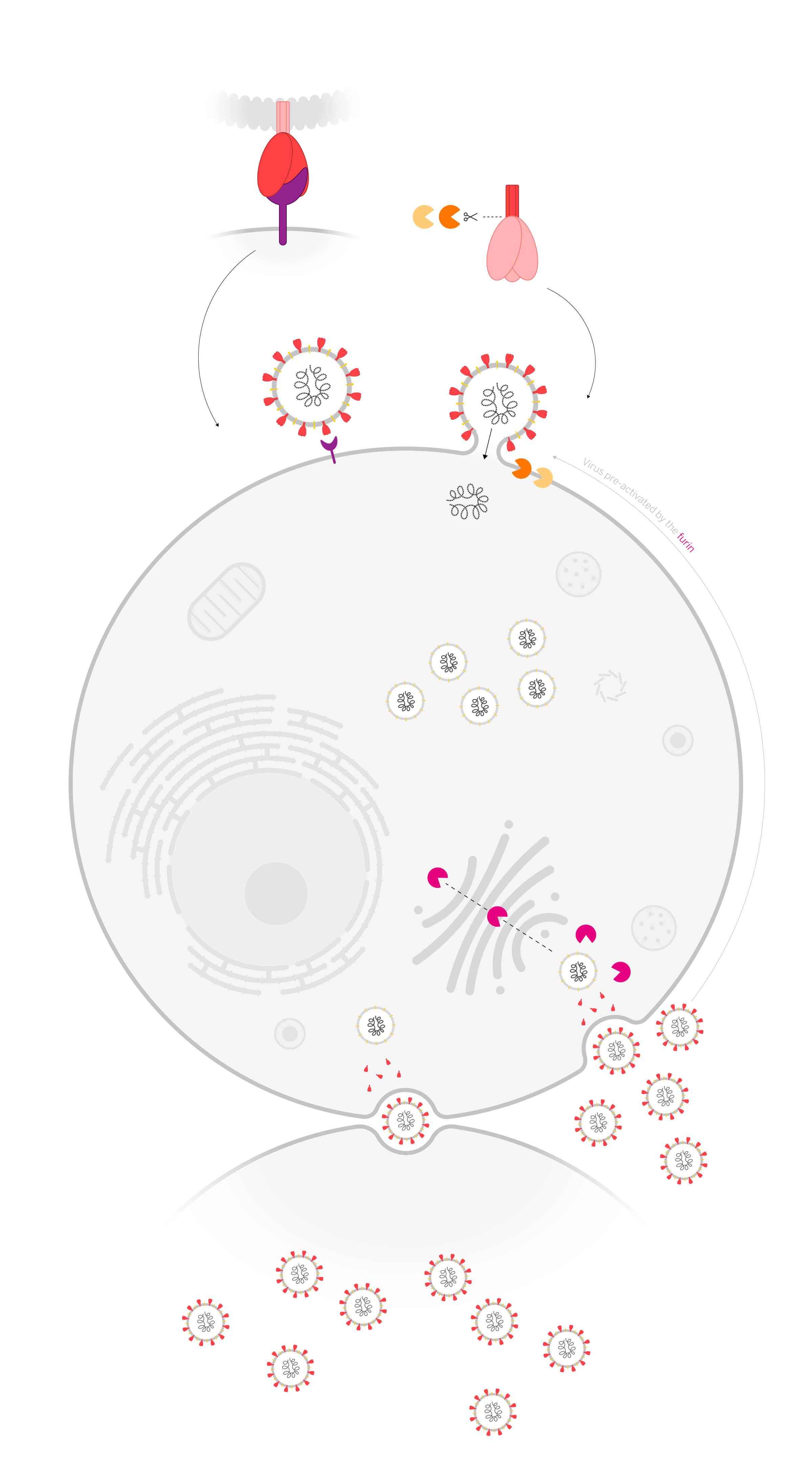
1.
The key¡¯s first step is to latch onto the human cell¡¯s ACE2 receptor, but that is not enough to actually invade it.
2.
The key¡¯s second step mediates fusion of the viral and host cell membranes.
Cleavage of the virus¡¯s spike protein is required for viral entry. The 2002 SARS virus, which is from the same family, took advantage of two ¡°scissors¡± that are present in only a few cells ¨C namely, the TMPRSS2 enzyme and the cathepsin enzyme.
Coronavirus
Spike protein
TMPRSS2
Cathepsins
Spike protein
ACE2
Receptor
Human
cell
But the SARS-CoV-2 also employs a third pair of scissors available from the furin.
The cleavage of the spike protein
and the binding with the cell.
Human
cell
The virus latches
onto the ACE2
receptor
RNA
TMPRSS2
Cathepsins
The virus releases its genome within the cell and starts to replicate.
To do this, it tricks the cell into creating virus proteins. These then assemble, multiply and start to infect other cells.
The virus¡¯s 12 extra letters create a site in the spike protein that can be cleaved by the furin enzyme which is present in almost all human cells, explaining this virus¡¯s elevated levels of contagion and virulence
Furin
Golgi
Apparatus
The furin makes the initial cleavage of the new virus¡¯s spike proteins, which now leave the human cell prepared for a new invasion.
Virus
pre-activated
by the furin
This initial cut allows the spike protein to start binding the infected cell to a healthy cell, enabling the virus to pass from one to another without being exposed to antibodies.
And so the process of infection and multiplication continues.
¡°We think that this insertion [of the 12 letters] allows the virus to enter into a larger spectrum of cells. This will probably favor the dissemination of the virus in the infected patients, and thus is probably key for the pathogenesis,¡± says French virologist Etienne Decroly, from Aix-Marseille University.
Decroly sounded the alarm on February 10, when many were still seeing the epidemic as an exotic problem specific to the distant Chinese city of Wuhan. At that stage only one person had died outside of China. But, according to Decroly, the new virus¡¯s spike proteins had an additional element that distinguishes it from the spike proteins of other similar coronaviruses ¨C the site where it could be cut by the furin enzyme turned it into a lethal weapon. ¡°The furin cleavage site is one of the reasons why SARS-CoV-2 is so transmissible,¡± agrees Fang Li, a virologist from the University of Minnesota who has just published a report in the scientific journal PNAS on the virus¡¯s ¡°amazing strategies¡± for entering human cells by circumventing the immune system.
Virologist Robert Garry has been studying the proteins of emerging viruses for more than 30 years. In 2005, Hurricane Katrina destroyed his laboratory at Tulane University in New Orleans where he kept samples of some of the first confirmed cases of the AIDS virus. Now he is researching the deviations of the new coronavirus. ¡°Acquisition of a furin site in an analogous site by low pathogenicity avian influenza viruses converts them to high pathogenicity avian influenza viruses,¡± says Garry, who wants to carry out research on animals to confirm his suspicions.
Stefan P?hlmann¡¯s team is researching the virus at the German Primate Center, a scientific facility housing more than 1,200 primates in the city of G?ttingen. ¡°Our data indicate that SARS-CoV-2 requires the furin motif in order to be able to efficiently enter human lung cells,¡± says P?hlmann, who has so far only published results from cell cultures in the laboratory. The German researcher, who is familiar with lethal viruses such as Ebola, believes that the involvement of the furin enzyme also allows the virus to invade cells in the digestive system and the kidneys, not just those in the respiratory system. The furin enzyme is also used by the Ebola virus as well as the dengue virus and HIV in their assaults on human cells. ¡°Furin is present in all cell types,¡± says Spanish National Research Council (CSIC) virologist Margarita del Val.
Furin was only identified in 1990, but it plays a fundamental role in the human body. Its snips activate the precursors of many of the proteins (proproteins) that perform the basic tasks of life. This enzyme is not only essential to the virus, but also to the person. ¡°Inhibiting furin would have toxic effects on cells,¡± says Colombian virologist Javier Jaimes, whose team at Cornell University in the US is looking for the SARS-CoV-2 virus¡¯s Achilles¡¯ heel in order to attack it with drugs. ¡°It could be a target for drugs tackling Covid-19, but it doesn¡¯t seem like the most ideal.¡±
Where do these 12 letters come from?
The origin of SARS-CoV-2 is not yet known, but scientists identify several possibilities:

1.
Creation in a laboratory from other viruses
RNA artificially modified
It is unlikely that someone manipulated these changes in a laboratory, but not impossible.
2.
Combinations
of other viruses
Combined RNA
3.
Random mutations of the virus itself.
Mutated RNA
The virus could have emerged in two ways.
a.
A virus from a bat evolved naturally in a host animal and made the leap onto humans with the 12 letters already written into its code.
Murci¨¦lago
In SARS, it was transmitted to humans via civets and in MERS via camels.
One theory says that SARS-CoV-2 made the leap via the pangolin.
b.
The virus leapt from animals to people and subsequently acquired the 12 letters.
Bat
It evolves
in the human
population.
Analysis of the genomes of the most closely related coronaviruses shows that only SARS-CoV-2 has the 12 letters that allow its spike protein to be activated by the furin enzyme, facilitating the invasion of various types of cells.
Genome letters
0
5,000
10,000
15,000
20,000
25,000
29,903
Spike
protein
First part
Second part
Here are the 12 letters
that make the new
coronavirus unique
Shared
Genome
SARS-CoV-2
96%
RaTG13
91%
Pangolin-Cov
80%
SARS-Cov-1
Animal
RaTG13
Pangolin-Cov
SARS-Cov-1
Bat
Pangolin
Human

1.
Creation in a laboratory from other viruses
RNA artificially modified
It is unlikely that someone manipulated these changes in a laboratory, but not impossible.
2.
Combinations
of other viruses
Combined RNA
3.
Random mutations of the virus itself.
Mutated RNA
The virus could have emerged in two ways.
a.
A virus from a bat evolved naturally in a host animal and made the leap onto humans with the 12 letters already written into its code.
Murci¨¦lago
In SARS, it was transmitted to humans via civets and in MERS via camels.
One theory says that SARS-CoV-2 made the leap via the pangolin.
b.
The virus leapt from animals to people and subsequently acquired the 12 letters.
Bat
It evolves
in the human
population.
Analysis of the genomes of the most closely related coronaviruses shows that only SARS-CoV-2 has the 12 letters that allow its spike protein to be activated by the furin enzyme, facilitating the invasion of various types of cells.
Genome letters
5,000
10,000
15,000
20,000
25,000
29,903
0
Spike
protein
First part
Second part
Here are the 12 letters
that make the new
coronavirus unique
Shared
Genome
SARS-CoV-2
96%
RaTG13
91%
Pangolin-Cov
80%
SARS-Cov-1
Animal
RaTG13
Pangolin-Cov
SARS-Cov-1
Bat
Pangolin
Human

Combinations of other viruses
Random mutations of the virus itself.
Creation in a laboratory from other viruses
Combined RNA
Mutated RNA
RNA artificially modified
It is unlikely that someone manipulated these changes in a laboratory, but not impossible.
The virus could have emerged in two ways.
A virus from a bat evolved naturally in a host animal and made the leap onto humans with the 12 letters already written into its code.
The virus leapt from animals to people and subsequently acquired the 12 letters.
Bat
Bat
In SARS, it was transmitted to humans via civets and in MERS via camels.
One theory says that SARS-CoV-2 made the leap via the pangolin.
It evolves
in the human
population.
Analysis of the genomes of the most closely related coronaviruses shows that only SARS-CoV-2 has the 12 letters that allow its spike protein to be activated by the furin enzyme, facilitating the invasion of various types of cells.
Genome letters
0
4,000
8,000
12,000
16,000
20,000
24,000
28,000
29,903
Spike
protein
First part
Second part
Here are the 12 letters
that make the new
coronavirus unique
Shared
Genome
Animal
SARS-CoV-2
Bat
96%
RaTG13
Pangolin
91%
Pangolin-Cov
Human
80%
SARS-Cov-1
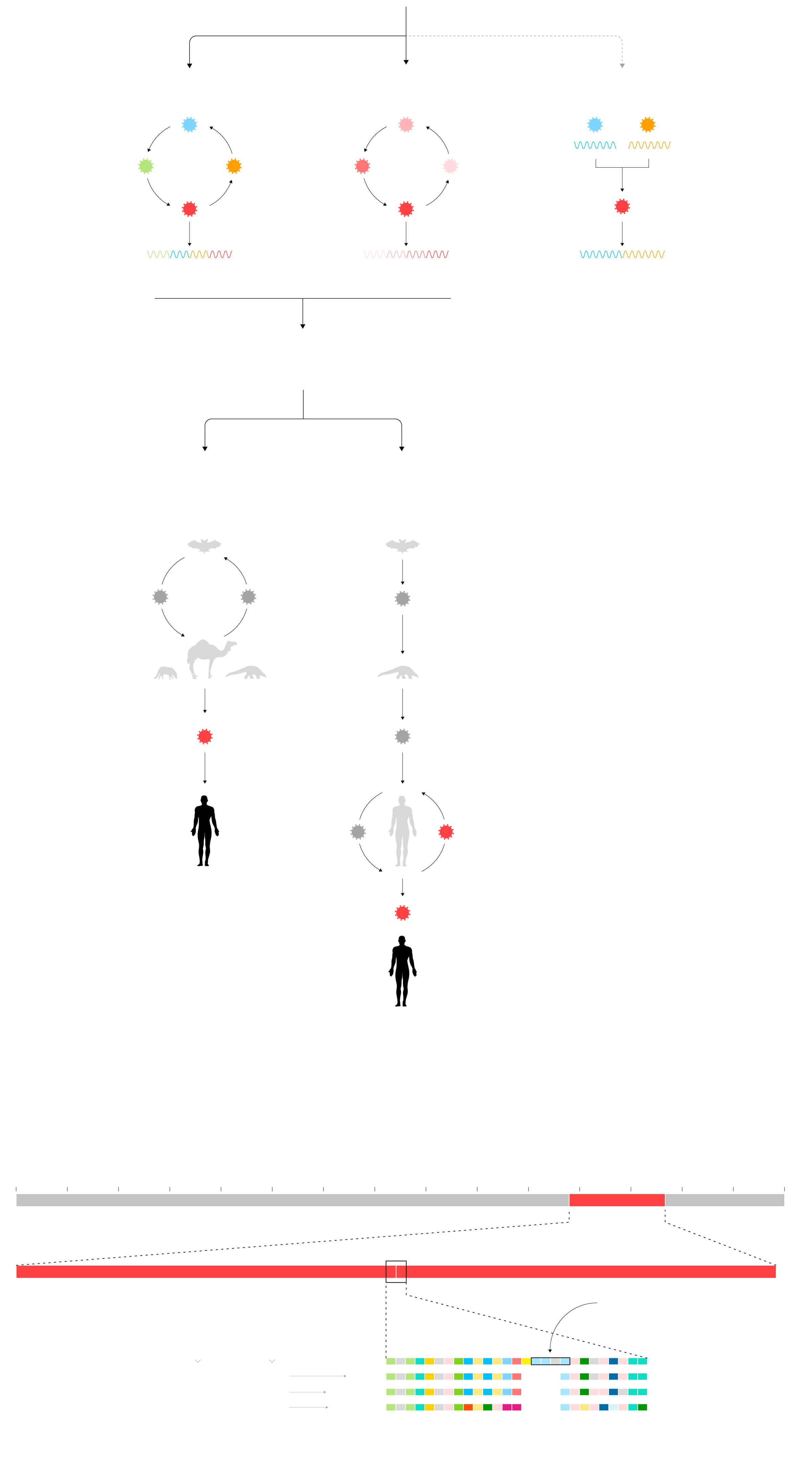
Combinations of other viruses
Random mutations of the virus itself.
Creation in a laboratory from other viruses
Combined RNA
Mutated RNA
RNA artificially modified
It is unlikely that someone manipulated these changes in a laboratory, but not impossible.
The virus could have emerged in two ways.
A virus from a bat evolved naturally in a host animal and made the leap onto humans with the 12 letters already written into its code.
The virus leapt from animals to people and subsequently acquired the 12 letters.
Bat
Bat
In SARS, it was transmitted to humans via civets and in MERS via camels.
One theory says that SARS-CoV-2 made the leap via the pangolin.
It evolves
in the human
population.
Analysis of the genomes of the most closely related coronaviruses shows that only SARS-CoV-2 has the 12 letters that allow its spike protein to be activated by the furin enzyme, facilitating the invasion of various types of cells.
Genome letters
0
2,000
4,000
6,000
8,000
10,000
12,000
14,000
16,000
18,000
20,000
22,000
24,000
26,000
28,000
29,903
Spike protein
First part
Second part
Here are the 12 letters that make
the new coronavirus unique
Shared
Genome
Animal
SARS-CoV-2
Bat
96%
RaTG13
Pangolin
91%
Pangolin-Cov
Human
80%
SARS-Cov-1
US President Donald Trump has advanced the theory that the virus escaped from the Wuhan Institute of Virology, located about 14 kilometers from the wet market thought to be the source of the pandemic. In advanced laboratories around the world, including Wuhan, so-called gain-of-function experiments are being conducted. These manipulate viruses to mutate in order to make them more contagious, more harmful and more resistant to treatment. The goal of these ¡°Frankensteins¡± is to accelerate the discovery of vaccines and drugs in anticipation of new pandemics. It is not deluded to think there may have been a leak, but there is no evidence to suggest this is what occurred.
American virologist Jack Nunberg conducted one such controversial experiment in 2006. He took the SARS-CoV-1 virus and inserted a site that could be cleaved by the furin enzyme. He does, however, believe that SARS-CoV-2 is the result of natural mutation. He argues that the genome of the new coronavirus has multiple differences besides the 12 letters compared to other coronaviruses. The most homogeneous virus is the bat coronavirus RaTG13, which only shares 96% of its genome with the current SARS-CoV-2. It is estimated that both diverged from the same virus about 52 years ago. In evolutionary terms, this ¡°is roughly like a human and a pig,¡± as geneticist Rasmus Nielsen from the University of California, in Berkeley, puts it.
The chance that someone would make all those changes in a laboratory is ¡°far-fetched but not impossible,¡± says Nunberg, now director of the Montana Biotechnology Center. ¡°Sadly, while I do not trust the Chinese to be transparent, I trust the conspiracy theorists (including my esteemed president) less. I don¡¯t think anyone knows enough to purposely engineer a new virus that is so successful,¡± he says. Nunberg points out that viruses are mutating all the time. And a single infected living being can have up to a trillion infectious viral particles from any given virus in its body. ¡°Never underestimate the ability of the virus to adapt,¡± he says. ¡°It¡¯s the 1,000 monkeys with typewriters who may eventually, at random, type out a Shakespeare play ¨C stuff happens¡±.
Sources: Stefan P?hlmann (German Primate Center), Margarita del Val (CSIC), Javier Jaimes (Cornell University), Etienne Decroly (Aix-Marsella University), Fang Li (University of Minnesota), Greg Bowman (University of Washington).